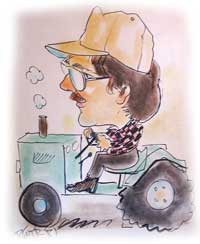Subscribe to
Posts [Atom]
Wednesday, November 18, 2009
Worth Checking Out
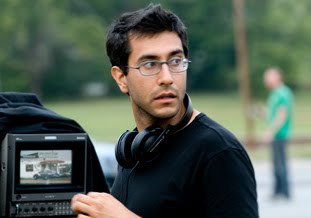 That's Ramin Bahrani, the native of Winston-Salem (born in 1975) who's becoming a talked-about creative force in the world of movies and whose most recent film, "Goodbye Solo," was shot entirely in Winston-Salem, except for the climax scene which was shot at the Blowing Rock with the wind sweeping up from below exactly the way it's supposed to.
That's Ramin Bahrani, the native of Winston-Salem (born in 1975) who's becoming a talked-about creative force in the world of movies and whose most recent film, "Goodbye Solo," was shot entirely in Winston-Salem, except for the climax scene which was shot at the Blowing Rock with the wind sweeping up from below exactly the way it's supposed to.Bahrani is Iranian-American, and his films have a definite knack for melding world-cultures and a humanistic spirtuality seen against the grittiest of urban backgrounds. "Man Push Cart" (2005) chronicled the tough life of an immigrant vending cheap food on the streets of New York City. "Chop Shop" (2007) follows a Latino street orphan hustling in the chaos of auto body shops in the very shadow of Shea Stadium.
In "Goodbye Solo" Winston-Salem has never looked worse, and I suspect the film might give the local Chamber of Commerce a bit of acid reflux, since this is not the Winston-Salem of Hanes Park and the Reynolda House. This is the Winston-Salem of decaying industry, abandoned warehouses, working-class neighborhoods, Quik Piks and strip malls. This is immigrant melting-pot America with Latinos, blacks, poor whites thrown together in the struggle for a slice of the pie.
The main character, Solo, is a Senegalese taxi driver who befriends an old white man who books Solo's taxi for a one-way trip to the Blowing Rock on October 20. Solo, who has a keen radar for fellow human beings, figures out that the old man intends to throw himself off the rock, and he sets about to prevent that.
I won't tell you what happens. See the movie. Then read the interview with Ramin Bahrani for additional insight into his philosophical outlook and his methods.
Labels: movies, Ramin Bahrani
Wednesday, October 14, 2009
The Best Movies You've Never Heard Of (Part II)
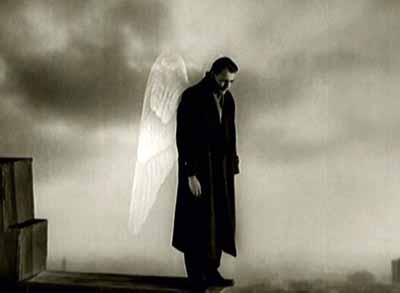 The self-indulgence continues. Anything to avert our gaze from Democratic Congressional "muddling through" and the further Republican descent into nasty irrelevance.
The self-indulgence continues. Anything to avert our gaze from Democratic Congressional "muddling through" and the further Republican descent into nasty irrelevance.19. The Trial (1962)
You'll either hate it or love it, and if you're in the "love it" camp with me, it'll be because of the sheer theatricality of the visual imagery, not because the story makes, uh, perfect sense or has a clear beginning, middle, and end. It's based on a Franz Kafka story, after all, so it's all about paranoia and motiveless malignity. Stars Anthony Perkins (a couple of years after he made Psycho) as the hapless "Josef K.," who finds he's an enemy of the state for reasons he can never figure out. The real star, however, is the great Orson Welles who directed it and also acts in it as a cigar-chomping lawyer. The set pieces are dazzling, in black and white (natch!).
20. I Am Cuba (1964)
I saw this amazing Russian-made propaganda piece only recently, and perhaps we're far enough away politically from the Cuban Revolution to view this incredibly beautiful docu-drama without the over-burden of debilitating politics. The film tells several peasant stories and makes the case, effectively, for revolution against the corrupt, cruel Baptista regime. It's the visuals, again, that make this movie riveting and unforgettable.
21. Wings of Desire (1987)
Believe in angels? Then this is the movie for you, though prepare yourself for the jolt of discovering that an angel's existence is fraught in ways you never could have guessed. They stand watch over all our human grief and fury and longing, forced to witness silently and absorb it all patiently, without the release of emotion. This is German director Wim Winders' great poetic ode to post-war Berlin, which, though bombed-out and strafed as it was, proved a lovely venue for the story of one angel's quest to be released from heavenly duty (and detachment), to take on human form and human joy and the muddiness of decay. The scenes shot in the immense Berlin public library are too haunting and beautiful for words.
22. Trainspotting (1996)
When I heard it dealt with heroin addiction, I avoided it. I'm squeamish about needles. Senator Bob Dole, running for president against Bill Clinton at the time, attacked the movie as a threat to American values (he later admitted he'd not seen the film). Well, given the provocation, how could I not eventually check out what was supposed to destroy my eternal soul, if not my patriotism? Amazingly, I found Trainspotting so ... jaunty and outrageously funny and very strangely logical and, yes, morally strict. The main character, played by young Ewan McGregor (long before he was Obi-Wan Kenobi in those dreadful "Star Wars" prequels) is totally self-aware and undeluded. He sez, ruefully but in self-defense: "Choose Life. Choose a job. Choose a career. Choose a family. Choose a fucking big television, choose washing machines, cars, compact disc players and electrical tin openers. Choose good health, low cholesterol, and dental insurance. Choose fixed interest mortgage repayments. Choose a starter home. Choose your friends. Choose leisurewear and matching luggage. Choose a three-piece suit on hire purchase in a range of fucking fabrics. Choose DIY and wondering who the fuck you are on Sunday morning. Choose sitting on that couch watching mind-numbing, spirit-crushing game shows, stuffing fucking junk food into your mouth. Choose rotting away at the end of it all, pissing your last in a miserable home, nothing more than an embarrassment to the selfish, fucked up brats you spawned to replace yourselves. Choose your future. Choose life... But why would I want to do a thing like that? I chose not to choose life. I chose somethin' else. And the reasons? There are no reasons. Who needs reasons when you've got heroin?" Expertly directed by Danny Boyle, who recently achieved the much more mainstream "Slumdog Millionaire" (go figure the karma of that!), this is the first great movie on my list that's actually in color.
23. The Journey of August King (1996)
Made on location in the western North Carolina mountains, based on Asheville writer John Ehle's novel about an escaped slave girl and the white farmer who helps her despite himself, and directed by an Australian who had the right touch for depicting American regional culture in the 1820s, this was the undiscovered gem of 1996. A movie with so much heart and so much scenic beauty and so much actual research into early settlement in these mountains, it should be on everyone's must-see list.
24. City of God (2002)
Directed by Brazilian filmmaker Fernando Meirelles, this portrait of the wild children of the streets in Rio de Janeiro earned Meirelles a Best Director Oscar nomination in 2004 (he lost to Peter Jackson for "Lord of the Rings"). Meirelles brings a tough humanism to those mean streets, depicting both the realities of lives trapped in violence and the possibility of escape.
25. Frida (2002)
Three major contributions to this sensual, sexy bio-pic of Mexican revolutionary artist Frida Kahlo: Selma Hayek, starring as the artist; the inventive, sensitive direction of Julie Taymor, the woman behind the Broadway version of "The Lion King"; and some of the actual artwork of Kahlo which not only decorates the narrative but comes to life in surprising ways. What is depicted actually happened (mainly), making the surrealism of Kahlo's art seem cosily domestic. Plus you get a pretty good dose of Mexican history in the early 20th century.
26. The Corporation (2004)
The only true documentary on this list, and the only documentary you'll ever need to understand the fix our democracy now finds itself in -- a country of, by, and for large corporations. Made by a Canadian team who were not blinkered by nationalistic pieties, this film will certainly educate you and might just change your life.
27. Hustle and Flow (2005)
I had not seen the movie when it's main song, "It's Hard Out Here for a Pimp," won the 2006 Academy Award for Best Original Song, beating out the far superior Dolly Parton song, "Travelin' Thru." I thought at the time, "Oh brother!" but then I got around to seeing the movie and discovered that it really IS hard out here for a pimp. In fact, the song -- the making of the song -- by pimp Terrence Howard is pretty much the plot of the movie, which is really in some sense a bio-pic about the city of Memphis, its black culture and its music scene. The fact that the writer/director of "Hustle and Flow" is a white boy from a privileged background just flat out amazes me, that he could muster that level of insight and empathy.
28. Paradise Now (2005)
A story about the recruitment, the training, and the self-doubt of Palestinian would-be suicide bombers, written and directed by an actual Palestinian. In other words, a dangerous subject told from a viewpoint not seen much in American media. It might have become a piece of pure propaganda, but that's not the case. It's a patient and understanding exploration of the social reality of that world and of its two main characters, childhood friends who have suffered under Israeli occupation and who have grown to hate and who are easily manipulated into wanting to end it all in a blaze of Israeli blood. I won't reveal what actually happens, but the focus is on the inner turmoil of one of those two boys, and it offers a perspective I'm glad to have.
29. The Squid and the Whale (2005)
Maybe the best movie ever made about the breakup of a marriage and the effects on children ... okay, a dark topic, but handled deftly (and with a lot of knowing humor) by writer/director Noah Baumbach, who drew on his own biography. Best thing: it stars Laura Linney as the mother, with Jeff Daniels as the father. I'd watch Laura Linney read the phonebook any day. With pleasure.
30. The Weather Man (2005)
When's the last time Nicholas Cage made a good movie? We date it to "Raising Arizona" and "Moonstruck" in 1987. Then came all that dreck, stuff like "Honeymoon in Vegas" and those awful "National Treasure" movies and (ick) "Ghost Rider." But tucked in there was this little adult gem, which absolutely nobody went to see but which deserved a big and wide audience. Cage plays a middle-aged man who earns a very good salary as a Chicago TV weatherman, without, ahem, meteorological qualifications. People hate him automatically because he forecasts the weather, and he often gets it wrong. His wife has left him, his kids are a trainwreck, his own father (played by Michael Caine) is a successful writer, a man with purpose and distinction in his life. The weatherman-son has neither. This is a comedy, yes, but also a serious look at the true nature of "success" and the importance of human connections.
31. Friends with Money (2006)
Written and directed by independent moviemaker Nicole Holofcener, with the radiant Catherine Keener (she who can do no wrong) and (surprise) Jennifer Aniston, playing very much against type as a poor woman who cleans other people's houses. It's an ensemble piece, featuring the intertwining lives and jealousies of four women friends, some of whom have money and some of whom don't, some of whom have men and some of whom don't. It's funny and carefully observed and nuanced ... all the qualities that mainstream Hollywood junk doesn't offer.
32. Brand Upon the Brain (2006)
One of the oddest, warped-est, funniest films you'll ever see, done by Canadian Guy Maddin very much in the style of mid-1920s German expressionist silent film with voice-over narration by Isabella Rossellini. If you have no taste for silent movies, you might want to avoid this. But if you like the pioneering achievements of early moving pictures, you'll find this "towering monument to weird" (as it's been described) both unforgettable and often laugh-out-loud funny. And you'll wonder, how did Guy Maddin do that?
33. I Served the King of England (2006)
A Polish movie about both Nazi-sympathizers and Nazi-haters in Poland before, during, and after World War II, but that's just the topic. The tone of this is pure hilarity, or at least dark comedy, with the main character a little Candide-like figure of surpassing innocence and wide-eyed acceptance, who drifts through life at everyone's beck and call. It's freakin' brilliant. And very sexy.
34. Lars and the Real Girl (2007)
One of the more improbable plot devices in these last hundred years! A shy, practically dysfunctional young man falls in love with a rubber sex doll that he insists on treating like a living person. In fact, he treats her like a mighty virgin and becomes her courtly, chivalrous suitor, while his family and community humors the delusion in hopes of helping him out of his shell. Family and community end up buying into the "humanity" of the doll themselves, and everybody is healthier for it. Sounds as bad as a movie plot could get, right? But it works and is howlingly funny to boot.
35. In Bruges (2008)
Colin Farrell's best movie evah. He plays a mob hit man who is terribly unqualified for the job because of his guilty conscience: on a recent snuff job in London, he accidentally killed a child, and he is totally haunted by that memory. The Big Crime Boss has sent him to Bruges, Belgium, the best preserved medieval city in all of Europe, to hide out. Farrell is accompanied by his closest friend and fellow assassin, who is both fatherly toward him and also secretly assigned to rub him out on the Big Boss's orders. Mayhem, death, and redemption follow. The plot is the least of it. The dialogue is some of the most hilariously profane I've ever encountered in any movie, outdoing even Scorsese. "Maybe that's what hell is, the entire rest of eternity spent in fucking Bruges."
36. JCVD (2008)
Brace yourself: those initials stand for "Jean-Claude Van Damme," the action hero from Belgium who has starred in many a wildly improbable shoot-'em-up, but this film is a rueful reexamination of all that film hype, a very thoughtful psychological study by the film star himself of the differences between film stardom and the grubby realities. So, yes, Jean-Claude Van Damme plays "J.C.V.D." who stumbles into a post office robbery gone very wrong. J.C.V.D. first gets blamed by the police for masterminding the crime (because, hey! He's Jean-Claude Van Damme, and this is the sort of thing he could do) and then becomes chief negotiator between the real criminals and the police. It's a tour-de-force of actual, genuine acting, brave in its self-exposure, especially when near the end Van Damme speaks directly to the audience about the wear and tear that his violent film career has had on his psyche and our complicity in trapping him with that super-hero image.
Labels: movies
Monday, October 12, 2009
The Best Movies You’ve Never Heard Of (Part I)
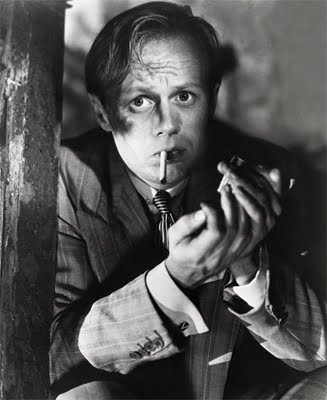 Here’s a modest list of movies to get hold of for the reasons outlined below. If you’re not a movie buff, you’ll want to stop now. If you consider yourself a movie buff, but don’t know squat about the pleasures of black-and-white cinematography, then it’s time you began to educate yourself. This list isn’t meant to be definitive. It’s eccentric as hell, with no attempt to account for the “best movies of all time” but only for the best movies I’ve been lucky enough to stumble across in my tireless search for the magic that can only happen while watching images projected in the dark. All of these were made by Americans and are deeply “American” in outlook and in technique. I mean no disrespect to our foreign makers of great films. I’ll get around to some of them in Part II.
Here’s a modest list of movies to get hold of for the reasons outlined below. If you’re not a movie buff, you’ll want to stop now. If you consider yourself a movie buff, but don’t know squat about the pleasures of black-and-white cinematography, then it’s time you began to educate yourself. This list isn’t meant to be definitive. It’s eccentric as hell, with no attempt to account for the “best movies of all time” but only for the best movies I’ve been lucky enough to stumble across in my tireless search for the magic that can only happen while watching images projected in the dark. All of these were made by Americans and are deeply “American” in outlook and in technique. I mean no disrespect to our foreign makers of great films. I’ll get around to some of them in Part II.1. Wild Boys of the Road/Heroes for Sale (1933)
Two height-of-the-Depression William A. Wellman features recently liberated to DVD in crisp restorations. If you’ve never delved into early talkie movies, here’s a place to start. The camera work is fluid and masterful, and the social commentary on a country coming apart at the economic seams may shock you, as will the frank depiction of drug addiction and sexual assault. This was pre-Production Code stuff, after all, before Hollywood started censoring itself to satisfy the blue noses.
2. Cat People (1942) /Curse of the Cat People (1944)
Val Lewton was the genius producer at RKO studios who pioneered the earliest “horror” genre, though confusing Lewton’s psychological studies with contemporary “horror” would be a serious mistake and will only lead to resentment and recriminations. This DVD disk features his first effort (Cat People) and (in my mind) his best (Curse of the Cat People). The Lewton atmospherics are all black-and-white spookiness. Because Cat People was a surprise hit, the studio demanded a sequel and insisted it be called Curse of the Cat People. Lewton took the title and then did what he pleased, which really has little to do with the first movie. Curse of the Cat People stands out as one of the few Hollywood movies that puts an innocent child under threat of bodily harm, and it looks deeply into the secret lives of children. If you prove yourself capable of appreciating Val Lewton’s art, you should then treat yourself to the other films in his “horror” series, all of them now available on DVD: I Walked With a Zombie (1943), The Leopard Man (1943), The Seventh Victim (1943), The Ghost Ship (1943), The Body Snatcher (1945), Isle of the Dead (1945), and Bedlam (1946). Nothing opened up my appreciation for black-and-white cinematography like these works.
3. The Ox-Bow Incident (1943)
Okay, you’ve heard of this one, but have you seen it? It’s another outstanding William A. Wellman-directed movie, a western totally unique in that every bit of it, stomping horses and all, was filmed on a sound stage rather than outdoors. Sounds unlikely, doesn’t it, but it actually works. It works primarily because of the dark psychology of mob violence and for the performance of Dana Andrews, one of the most underrated actors in Hollywood back then, as a falsely accused drifter. Wellman was a master of the basics – where to put the camera in order to tell a suspenseful story.
4. Detour (1945)
Low-budget, mean-spirited, bleak in outlook, where would you find a darker film that better summed up the trapped American male of post World War II America? This strange, almost hallucinatory yarn has attracted a cult following, particularly because of its female star, the appropriately named Ann Savage, who dismantles gonads as a hobby.
5. Born to Kill (1947)
It may be obvious by this point that I love black-and-white crime and suspense movies, and there are thankfully many to watch on DVD in beautifully restored versions. This one, directed by Robert Wise, stars Lawrence Tierney, who plays a thug as well as a thug has ever been played. Tierney was a much-used “heavy” in the movies and did a ton of TV work before his death in 2002. He’s beloved in my household for the one episode of Seinfeld he appeared on, playing Elaine Benes’s intimidating father (the episode when Jerry turns his new suede coat inside out to save it from the weather, only to become the “pink boy” to Elaine’s hyper-virile father, who already thinks everyone he meets is gay). Tierney appears in Born to Kill opposite Claire Trevor, as the wicked woman. Also features the ever dependable Elisha Cook Jr. as the squirrelly side-kick.
6. The Naked City (1948)
Directed by Jules Dassin on location in New York City at a time when Hollywood movies were rarely shot on location. This is the movie that launched the TV show of the same name that dominated 1950s TV dramas. Gritty realism, police procedure, masterful camera work from a filmmaker who probed deeply into the American underbelly and who got himself blacklisted as a Commie for his efforts. This is the first of four Dassin movies on this list, which would make him, if not my favorite director of all time, at least my favorite dead director of all time.
7. The Set-Up (1949)
Another Robert Wise-directed film, starring Robert Ryan playing a long-shot boxer wearing the whiff of failure. He’s so washed up as a prize fighter than his own manager sells him out to the Mob. This is the ultimate realistic film about the corrupt world of professional boxing, done in real time, which is to say that the story as told lasts 72 minutes, which is the precise running time of the movie.
8. Gun Crazy (1949)
Also known as “Deadly Is the Female,” and they ain’t kidding! Oh my God, if you’re a film nut and haven’t seen this, you’re not going to believe your eyes. Directed by the little known Joseph H. Lewis, this movie is like no other noir you’ve ever seen. From the brilliant entrance of the deadly femme Annie Laurie Starr, the blond carnival performer with guns in both hands, to the famous long single take of a bank robbery and getaway in progress, all shot from the backseat of the getaway car, Lewis shows you what a master could do with no budget to keep you riveted on the screen.
9. Thieves Highway (1949)
The second of my Jules Dassin movies on this list, starring one of my favorite actors from this period, Richard Conte. Dassin always takes the side of “working stiffs,” and Conte is just a common man, a war veteran, trying to earn a living hauling fruit to the San Francisco fresh-market brokers. The main villain is the boss broker, played well by professional heavy Lee J. Cobb.
10. The Asphalt Jungle (1950)
You’re bound to have heard of this one, if for no other reason because of the brief small role by a very young Marilyn Monroe, but this well textured crime drama directed by John Huston is essential to your appreciation of what black-and-white cinematography achieved as an art form. Remarkable for Sterling Hayden’s starring role as a “hooligan” with a dream of horse farms in Kentucky and for the surprise casting of little Sam Jaffee (most famous, perhaps, for playing Einsteinian eggheads and philosophers) as the criminal mastermind with a foreign accent. The Jaffee character says ruefully at one point, “Experience has taught me never to trust a policeman. Just when you think one’s all right, he turns legit.”
11. Night and the City (1950)
Jules Dassin again. This film, starring Richard Widmark as a loser-hustler, was made entirely on location in London, England, where Dassin had gone to evade the Hollywood blacklist. He had been “outed” as a past member of the American Communist Party (back in the agitated 1930s) and was not going to be able to work again, but Darryl F. Zanuck, head of 20th Century Fox, gave him this assignment to be completed in England, thus avoiding the blacklist. Dassin never made a film in the U.S. after this, nor another film for an American producer. Both Dassin and Widmark died within days of one another in 2008.
12. No Way Out (1950)
Starring Richard Widmark, who was typecast often as a vicious character, and Sidney Poitier in his first screen appearance as a black doctor who must save the life of a white racist who hates his guts (Widmark). Poitier was 22 years old when he made this film. Widmark, though he played a lot of psychotics, was by all reports the gentlest and kindest of men. Startling that such material got an airing in the Age of Eisenhower, particularly some of the racist language that comes out of Widmark. Written and directed by Joseph L. Mankiewicz, this amazing movie features a vivid race riot that strips the hide off American illusions of equality.
13. Panic in the Streets (1950)
Richard Widmark again, this time playing the good guy, a Naval medical officer trying to head off an epidemic of plague in New Orleans, which is being unwittingly spread by a creepy member of the underworld played by Jack Palance. Directed by Elia Kazan. Gorgeous black and white photography.
14. 14 Hours (1951)
The ultimate man-on-a-ledge suspense thriller, with Richard Basehart threatening to jump for the 14 long hours of the title, while gentle schlub policeman Paul Douglas tries to talk him out of it. Things only get worse when the jumper’s girlfriend and mother show up, leaving his motives for suicide a little easier to figure. The clarity of the black and white photography is just so crisp on the DVD.
15. Ace in the Hole (1951)
Only recently liberated from film archives to DVD, this Kirk Douglas feature is one of Billy Wilder’s best films and one of the least known. Based loosely on the famous Floyd Collins case in 1920s Kentucky, when Collins got stuck in a cave hunting Indian relics while hundreds of rescuers worked over several days to free him. The Collins episode captivated the attention of the entire nation. This Billy Wilder version is moved to the New Mexico outback (it was filmed on location near Gallup, N.M). Wilder turns it into a probing examination of the American love of spectacle, as the attempt to rescue a man trapped in a cave turns into a “big carnival” (which was the alternate title for the movie). Kirk Douglas plays a newsman-on-the-make who happens to be in the right place at the right time to “own” the story of the rescue. When other news reporters try to get access, one of them reasons with Douglas: “We’re all in the same boat.” The Douglas character answers, “I’m in the boat. You’re in the water. Now let’s see how you can swim.” This is an abrasive portrait of American hucksterism like none you’ve ever seen.
16. The Desperate Hours (1955)
You’re a nice, respectable American businessman living in an upscale American suburb, with a nice wife and two nice kids. And one day a desperate escaped convict (played very well by an aging Humphrey Bogart) and his two escaped convict pals break into your home and hold you and your family hostage. Directed by William Wyler, this little black and white thriller is appropriately claustrophobic, and Bogart is just fine playing bad.
17. Rififi (1955)
The last of the Jules Dassin movies on this list, this one was filmed five years after “Night and the City,” a span of time during which the genius Dassin could not get work. He was handed this script by French movie producers, who wanted a little crime drama about dark-skinned North African immigrants in Paris robbing a famous jewelry store. Dassin shaped the material in a different direction, turning the robbers into his own brand of working-class heroes, and filming one of the most amazing 30-minute robbery sequences, with hardly a word of dialogue. Dassin himself took the role of one of the robbers under the screen name of “Perlo Vita.” I could rave about this film at length. Suffice it to say that Dassin was one of America’s great filmmakers who was driven from our shores by intolerance and political bigotry, which makes him doubly a hero.
18. Odds Against Tomorrow (1959)
Another Robert Wise-directed movie, this one remarkable in many ways – for casting singer Harry Belafonte totally against type as a small-time crook, for casting Robert Ryan totally according to type as a slightly bigger-time crook with another racist chip on his shoulder about having to team up with a black man, and for Ed Begley Sr. as the most unlikely mastermind of a big bank heist. The movie is also distinguished by a pulsing jazz soundtrack, quite unusual at the time. With this movie, we’re at the end of that incredible long period of distinctive, astounding black and white artistry that really defined the movie experience in America for decades ... before color photography and computer-generated-imagery ruined everything.
Labels: movies
Wednesday, September 23, 2009
Golly, What a Good Movie!
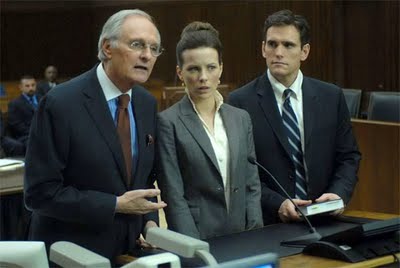 "Nothing But the Truth," 2008, written and directed by Rod Lurie, suggested by (though not based on the details of) the Valerie Plame Affair and the subsequent jailing of NYTimes reporter Judith Miller for refusing to divulge her source to a special prosecutor.
"Nothing But the Truth," 2008, written and directed by Rod Lurie, suggested by (though not based on the details of) the Valerie Plame Affair and the subsequent jailing of NYTimes reporter Judith Miller for refusing to divulge her source to a special prosecutor.The journalist heroine of this movie (played by Kate Beckinsale, who should have been nominated for multiple awards for this role, and should have won them all) is not based on Judith Miller, which is a relief, though the wringer she is put through in this story makes me reevaluate my attitudes toward Miller during the Plame investigation. I did not look on Judith Miller at the time as a heroine of journalism. Maybe I should have.
Some 49 states of our Union now have laws on the books explicitly protecting journalists from the power of the State to compell them to divulge confidential sources of information. Only the federal government (and poor freakin' Wyoming!) has no such shield laws, and it's precisely the power of the federal government that needs constant exposure (I don't care who's president). The power of our federal government to chill the flow of information, to stifle free speech with intimidation, with the prosecution of good people (journalists, truth-seekers, whistle-blowers) under the guise of "national security" ... that's the great theme of "Nothing But the Truth." (Incidentally, the title of this otherwise near-perfect movie totally bothers me. "Nothing But the Truth" sounds like either a standard gee-aren't-lawyers-sexy courtroom drama or a dumb romantic comedy about Jim Carrey's inability to lie. Oh well, you can't have everything ... like a smashingly good title that's both memorable and captures the gist.)
Great actors in this film, along with Beckinsale (who is seriously just ... too much), including...
Vera Famiga, of the killer blue eyes, who was so radiant as the therapist in "The Departed," as the outed CIA spy
Matt Dillon (of all people!), playing triumphantly against type as the super-smart, sharklike special prosecutor
David Schwimmer (yes, of "Friends" fame), proving he's a subtle and serious actor in a terrifically difficult part as the journalist's not-up-to-the-challenge husband
Alan Alda as the complex defense attorney and First Amendment crusader
Angela Bassett as the editor in chief of the prestigious Washington newspaper whose star reporter gets the biggest story of her career and goes to jail for it
I understand that "Nothing But the Truth" got no theatrical release (or very little) and went straight to DVD, usually a sign that the movie's no good, or deeply flawed. Apparently, distributors thought there would be no appetite among the American movie audience for a serious, taut drama on such topics as freedom of the press and a willingness to go to the wall over principle. Maybe those distributors were right.
Or maybe it was the title.
Labels: free speech, movies
Thursday, June 25, 2009
Lights! Camera! Action!
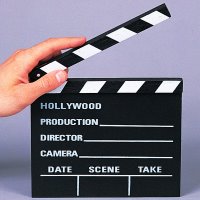 We're generally not agreeable about government-funded corporate welfare. As a rule, it makes us dyspeptic. But this idea currently up in the N.C. General Assembly, has our full support.
We're generally not agreeable about government-funded corporate welfare. As a rule, it makes us dyspeptic. But this idea currently up in the N.C. General Assembly, has our full support.According to the N.C. Film Office, in the past 27 years some 800 movies and 15 TV series have been filmed in our state, vastly enriching the local areas where they set up with jobs (temporary, but still), props, services, even the occasional trained dog. Having supplied props and furniture to both "The Winter People" (1989) and "The Last of the Mohicans" (1992), we loved to see "the movie people" coming. Generally, they paid cash.
Don't know what the current statistics are, but back in the mid-1990s North Carolina had risen to third among all the states for on-location movie production, behind California (duh) and New York. Third. There for a while we were experiencing a building boom of studio facilities. The best known and largest is in Wilmington, but they're scattered through the middle of the state too. That's infrastructure ... and jobs, lots of jobs. How many extras, weapons experts, horse wranglers were hired for just "The Last of the Mohicans"? Thousands. The ripple effects are pronounced. Our western mountains are still visited by people who were first stunned to see them represented in that Michael Mann movie.
In fact, it was the movies that put Hendersonville, Hickory Nut Gap, Bat Cave, and Chimney Rock on the map back before World War I. When I was actively researching Hollywood history, I was astounded to discover that film crews were flocking to Asheville and Hendersonville every summer beginning in 1910 to make dozens of "two-reelers" that were shown in the nickleodeons of New York, Philadelphia, and Boston. Hickory Nut Gap and Chimney Rock got utilized repeatedly as background for moonshiner and feud shoot-'em-ups as well as a series of movies about the Royal Canadian Mounted Police. Those silent films didn't create Asheville as a destination, but they certainly didn't hurt. Movie crews and troops of actors regularly monopolized the rooms at the Esmeralda Inn, that historic stopping-off place near Bat Cave that (alas) burned down (again!) a few years ago.
What's being proposed in the General Assembly is a very modest tax rebate, a far more productive investment, IMHO, that the millions offered Dell, Google, and various other corporate flim-flammers.
Labels: movies
